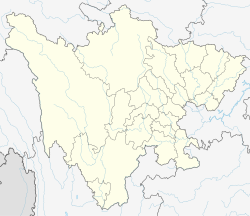world.wikisort.org - China
Butuo County (Chinese: 布拖; pinyin: Bùtuō) is a county of southern Sichuan Province, China. It is under the administration of the Liangshan Yi Autonomous Prefecture. It was incorporated in 1952,[1][additional citation(s) needed] and has continuously existed since 1960. The name 'Butou' is based on the Yi language words for hedgehog and pine tree, giving it the name "a place with hedgehogs and pine trees". It is the unofficial capital of the Yi People and the birthplace of the Torch Festival.[2] The county has a population of 215,800, 97.2% of whom are Yi People.[3]
Butuo County
布拖县 | |
|---|---|
County | |
 Butuo Location in Sichuan | |
| Coordinates: 27°36′N 102°52′E | |
| Country | People's Republic of China |
| Province | Sichuan |
| Autonomous prefecture | Liangshan Yi Autonomous Prefecture |
| Township-level divisions | 3 towns 27 townships |
| County seat | Temuli (特木里镇) |
| Area | |
| • Total | 1,685 km2 (651 sq mi) |
| Elevation | 2,398 m (7,867 ft) |
| Highest elevation | 3,891 m (12,766 ft) |
| Lowest elevation | 535 m (1,755 ft) |
| Population (2017) | |
| • Total | 215,800 |
| • Density | 130/km2 (330/sq mi) |
| Time zone | UTC+8 (China Standard) |
| Website | www |
Butou is considered very impoverished, traditional and still significantly influenced by the legacy of feudalism and slavery, which was only reformed in the 1950s.[4] Most villagers make a living through animal husbandry. Almost all of the non-agrarian economy is concentrated in the county seat.[1] It is a 'key county' for National Poverty Alleviation and Development work, with as of 2018, 122 poverty-stricken designated villages in the county, and 57,000 poor people.[5]
The bamboo mouth harp (Kouxian) of Butou County was included as intangible cultural heritage of the Yi People.[6]
Administrative divisions
Butuo County administers 3 towns and 27 townships.
Towns:
- Temuli (特木里镇)
- Longtan (龙潭镇)
- Tuojue (拖觉镇)
Townships:
- Mu'er (木尔乡)
- Jiudu (九都乡)
- Lada (拉达乡)
- Wuke (乌科乡)
- Shaluo (沙洛乡)
- Luogu (洛古乡)
- Bu'er (补尔乡)
- Juesa (觉撒乡)
- Meisa (美撒乡)
- Laguo (拉果乡)
- Wuyi (乌依乡)
- Langzhu (浪珠乡)
- Baoguping (包谷坪乡)
- Hejing (合井乡)
- Luojiaping (罗家坪乡)
- Niujiaowan (牛角湾乡)
- Buluo (补洛乡)
- Huolie (火烈乡)
- Le'an (乐安乡)
- Sike (四棵乡)
- Diluo (地洛乡)
- E'liping (俄里坪乡)
- Wadu (瓦都乡)
- Caiha (采哈乡)
- Weizhiluo (委只洛乡)
- Lianbu (联补乡)
- Jizhi (基只乡)
Climate
| Climate data for Butuo (1981−2010) | |||||||||||||
|---|---|---|---|---|---|---|---|---|---|---|---|---|---|
| Month | Jan | Feb | Mar | Apr | May | Jun | Jul | Aug | Sep | Oct | Nov | Dec | Year |
| Record high °C (°F) | 21.3 (70.3) |
24.1 (75.4) |
26.5 (79.7) |
28.8 (83.8) |
29.9 (85.8) |
29.7 (85.5) |
28.9 (84.0) |
28.5 (83.3) |
29.5 (85.1) |
25.9 (78.6) |
22.3 (72.1) |
21.7 (71.1) |
29.9 (85.8) |
| Average high °C (°F) | 9.7 (49.5) |
12.1 (53.8) |
16.3 (61.3) |
19.4 (66.9) |
20.8 (69.4) |
21.2 (70.2) |
22.5 (72.5) |
22.4 (72.3) |
19.6 (67.3) |
16.0 (60.8) |
13.2 (55.8) |
10.4 (50.7) |
17.0 (62.5) |
| Daily mean °C (°F) | 2.2 (36.0) |
4.6 (40.3) |
8.2 (46.8) |
11.7 (53.1) |
14.1 (57.4) |
15.9 (60.6) |
17.2 (63.0) |
16.6 (61.9) |
14.1 (57.4) |
10.4 (50.7) |
6.4 (43.5) |
2.9 (37.2) |
10.4 (50.7) |
| Average low °C (°F) | −2.8 (27.0) |
−0.7 (30.7) |
2.3 (36.1) |
5.8 (42.4) |
9.1 (48.4) |
12.1 (53.8) |
13.1 (55.6) |
12.3 (54.1) |
10.3 (50.5) |
7.0 (44.6) |
2.0 (35.6) |
−1.9 (28.6) |
5.7 (42.3) |
| Record low °C (°F) | −17.4 (0.7) |
−12.4 (9.7) |
−9.3 (15.3) |
−9.5 (14.9) |
0.0 (32.0) |
4.7 (40.5) |
4.8 (40.6) |
3.4 (38.1) |
0.8 (33.4) |
−2.3 (27.9) |
−11.2 (11.8) |
−25.4 (−13.7) |
−25.4 (−13.7) |
| Average precipitation mm (inches) | 14.7 (0.58) |
16.9 (0.67) |
29.0 (1.14) |
57.8 (2.28) |
127.7 (5.03) |
216.6 (8.53) |
204.0 (8.03) |
149.4 (5.88) |
151.8 (5.98) |
97.3 (3.83) |
31.5 (1.24) |
13.3 (0.52) |
1,110 (43.71) |
| Average relative humidity (%) | 68 | 62 | 60 | 64 | 72 | 81 | 82 | 81 | 83 | 84 | 78 | 73 | 74 |
| Source: China Meteorological Data Service Center[7] | |||||||||||||
References
- Thomas Heberer (1 September 2012). Doing Business in Rural China: Liangshan's New Ethnic Entrepreneurs. University of Washington Press. p. 58. ISBN 978-0-295-80409-5.
- "历史沿革". www.bt.gov.cn.
- "布拖概况". www.bt.gov.cn.
- Hill, Ann Maxwell (2001). "Captives, Kin, and Slaves in Xiao Liangshan". The Journal of Asian Studies. 60 (4): 1033–1049. doi:10.2307/2700019. JSTOR 2700019. S2CID 145130654 – via JSTOR.
- "【脱贫攻坚在凉山】布拖县亚河村:解锁脱贫致富新模式" [[Tackling poverty in Liangshan] Yahe Village in Butuo County: Unlocking a new model of poverty alleviation]. news.cctv.com.
- Keith Howard (29 April 2016). Music as Intangible Cultural Heritage: Policy, Ideology, and Practice in the Preservation of East Asian Traditions. Taylor & Francis. p. 137. ISBN 978-1-317-09216-2.
- 中国地面气候标准值月值(1981-2010) (in Simplified Chinese). China Meteorological Data Service Center. Retrieved 20 October 2018.
External links
На других языках
- [en] Butuo County
[ru] Буто (Ляншань)
Буто́ (кит. упр. 布拖, пиньинь Bùtuō) — уезд Ляншань-Ийского автономного округа провинции Сычуань (КНР). Название уезда является словом из языка народности и.Другой контент может иметь иную лицензию. Перед использованием материалов сайта WikiSort.org внимательно изучите правила лицензирования конкретных элементов наполнения сайта.
WikiSort.org - проект по пересортировке и дополнению контента Википедии